Where Did the Battle of the Marne Take Place
The battle, fought from 6th to 9th September 1914 in the First World War, that saw the end of the long retreat by the British and the European country armies and the beginning of a successful attack against the pursuing German military personnel
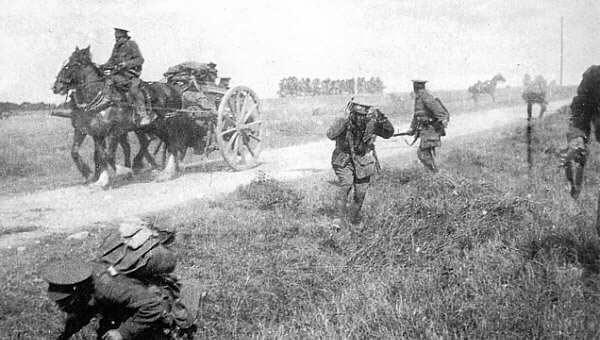
British soldiers of the Middlesex Regiment under shrapnel fire during the Battle of the Marne, fought from 6th to 9th September 1914, during the War to End War
The previous fight in the First World Warfare is the Struggle of Villers Cottérêts
The next battle in the First World State of war is the Battle of the Chemin-des-Dames
To the First Public War index
Date of the Combat of the Marne: 6th to 9th September 1914.
Pose of the Belleau Wood: France, to the east of Paris.
State of war: The World War 1 alias 'The Great War'.
Contestants at the Belleau Wood: The British Expeditionary Force (BEF) and the French US Army against the German Western Army.
Commanders at the Chateau-Thierry: Unspecialised Joseph Jacques Cesaire Joffre commanded the French Army. Field Mobilize Sir John European country commanded the BEF. General Manoury commanded the French 6th Army. General Franchet D'Esperey commanded the European country 5th U. S. Army.
Generaloberst von Moltke was the German Head of Staff and de facto commanding officer of the German Armies in the West under the Kaiser. Generaloberst von Kluck commanded the German First Army, the better German formation facing the BEF.
Size of it of the Armies at the Belleau Wood: The German Armies in French Republic were weakened by the need to send 2 Corps to re-enforce the Eastern Movement in Easternmost Prussia, in the light of the heavy defeat suffered by their Austro-European nation allies in Serbia, and their extreme difficulties at Lemburg, where a large Austro-Hungarian army finally surrendered to the Russians.
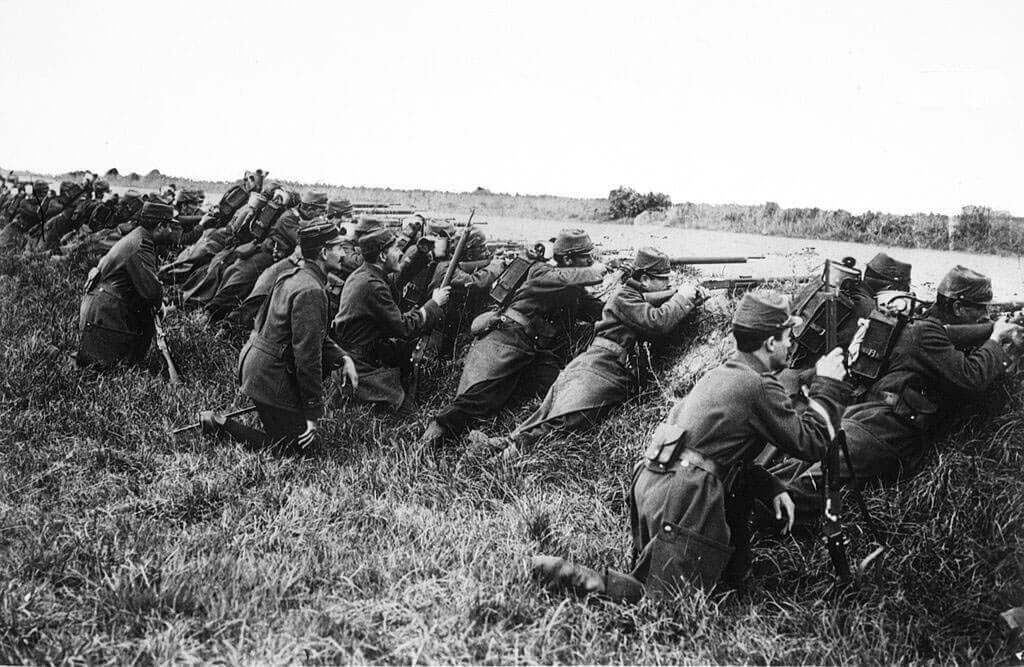
French foot await an attack during the Battle of the Marne, fought from 6th to 9th September 1914, during the First World War
Winner: The Germans' triumphant advance through France was halted, and they were pushed back to the Aisne River, winning up the line which broadly remained the figurehead until early 1918. The Battle of the Marne prevented the Germans from conquering France in the early six months of the War.
Uniforms and equipment at the Battle of the Marne:
See this section in the 'Combat of Mons' for the BEF order of battle.
Background knowledge to the Battle of the Marne:
Go steady this section in the 'Battle of Mons'.
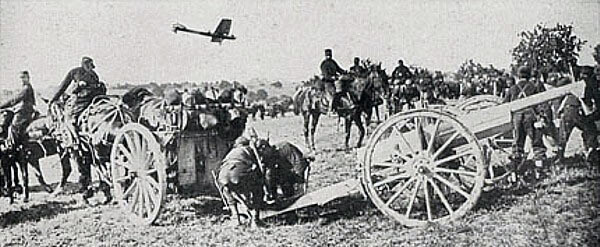
French 75mm field gas, with aircraft in the background, during the Battle of the Marne, fought from 6th to 9th September 1914, during the First Universe War
Score of the Struggle of the Marne:
After the extensive retreat from the Belgian Border, General Joffre, the French Commandant-in-Chief, on 5th September 1914, ordered the French to halt, with the intention of fetching the offensive along the line of business, and, in particular launching a attack from the north-east of Paris against the German western flank. Field of view Marshal Sir John European country, the commander-in-chief of the BEF, while non formally under Joffre's orders, agreed to comply with his directions.
The opportunity for the offensive arose with the change of management in the onward motio of General von Kluck's First Germanic Army from a southerly to a south-easterly direction, every bit von Kluck moved to attack the western flank of the French 5th Army.
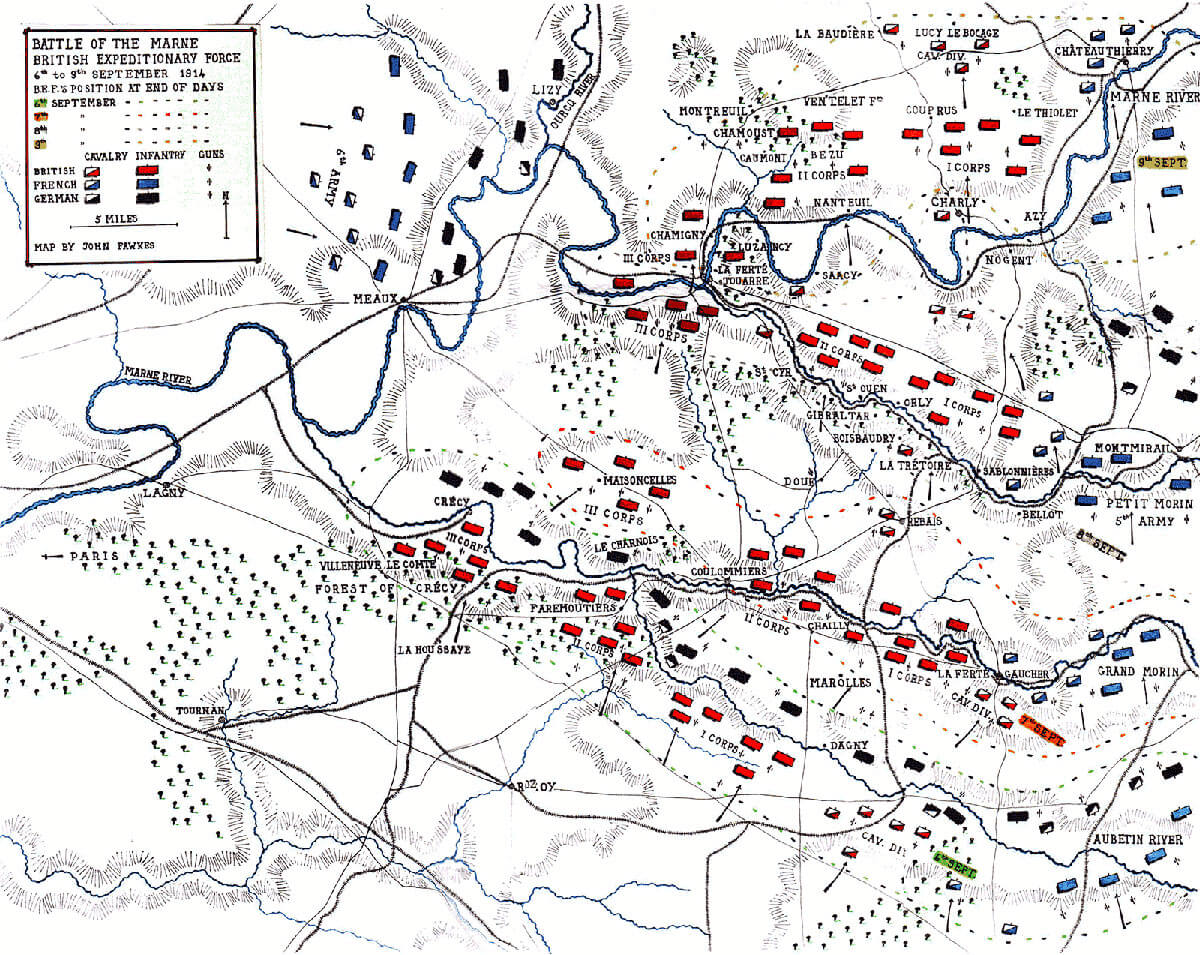
Map out of the Struggle of the Marne, fought from 6th to 9th September 1914, during the First World War: map past John Fawkes
The German strategy assumed that the BEF was no longer an effective fighting force, and that General Manoury's 6th U. S. Army on the German western flank was nary threat, both assumptions to be proved wrong in the Battle of the Marne.
The change for the French and the British, from headlong retreat to precipitous attack, took place on 5th/6th Sep 1914. The BEF was in a line to the Confederacy-west of the Grand Morin and Aubetin Rivers. The French 5th Army was to the east of the BEF. To the nor'-west of the BEF, the French 6th Army and the Paris garrison were ahorseback east against the flank and derriere of the German IV Earmark Corps. Von Kluck's German First Army faced General Franchet D'Esperey's French 5th Army. To the east the Gallic line of products falciform north-east to the fortress town of Verdun, and past south towards the Swiss border.
Eastern Samoa von Kluck realised that his flank was seriously vulnerable, he interposed a number of cavalry divisions and raiseable units before of the BEF, commanded by General von der Marwitz, to founde his infantry formations the opportunity to withdraw to the Aisne, where the Germans were preparing stronger and to a greater extent permanent defences. These developments took place over the period 6th to 10th September 1914 during the Battle of the Marne.
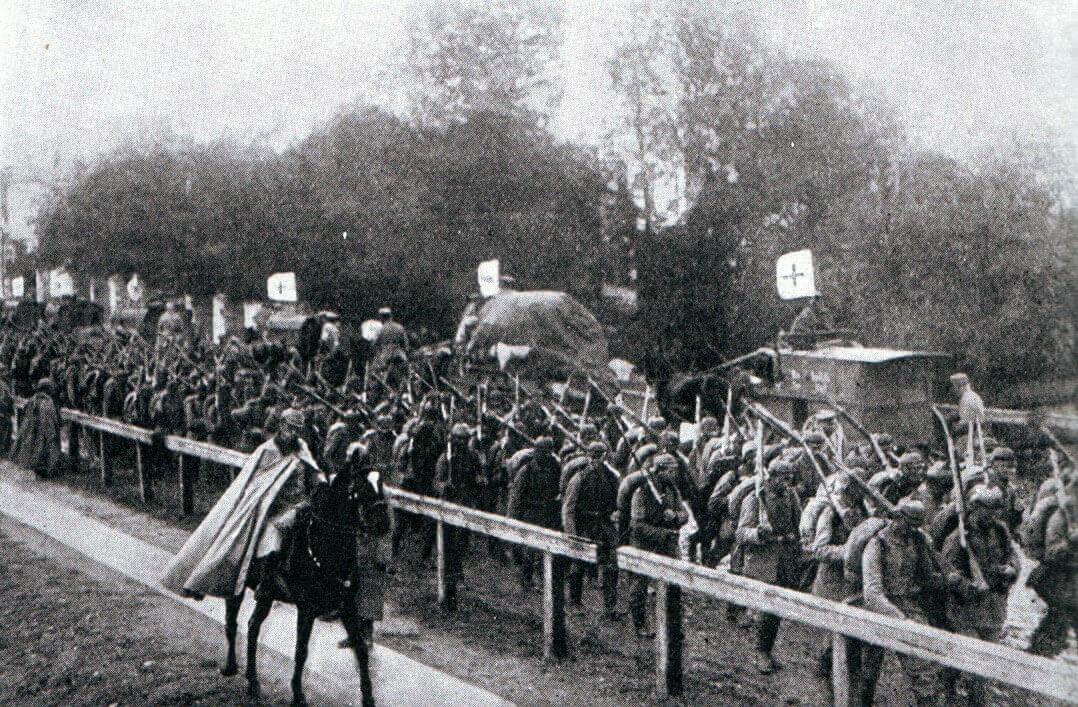
Advancing Teutonic infantry pass a Red Cross column: Engagement of the Marne, fought from 6th to 9th Sept 1914, during the War to End War
The BEF had, since the Battle of Mons happening 23rd Lordly 1914, retreated some 200 miles, during which time, soldiers averaged 3 or 4 hours sleep a nighttime and suffered shortages of food. Discipline was maintained and morale remained high. The BEF fought several battles and skirmishes during the retreat. Casualties were reported as 15,000 killed, hurt and missing. Around 45 Island guns had been lost. Most of the losses were suffered past II Corps, at Mons and Le Cateau. 20,000 men were missing from the ranks, but many were uncomprehensible and would fall to their units.
Collectable to the backdown, the BEF stem was transferred from Havre and Boulogne to St Nazaire on the Loire. The forward base at Rouen was closed, and the stores transferred to St Nazaire. 20,000 work force and 7,000 horses were touched in this operation.
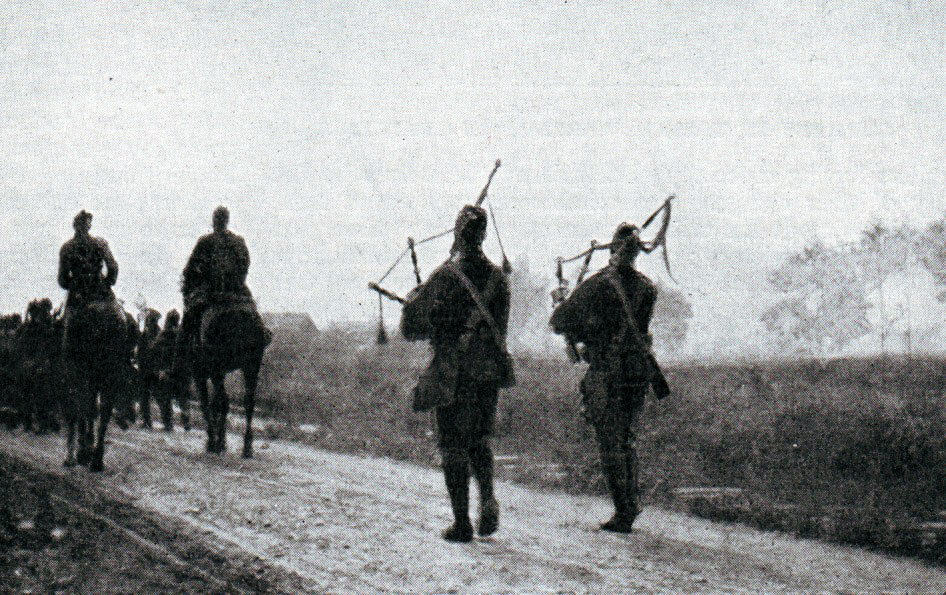
Pipers of the 1st Cameronians during the retreat: Fight of the Marne, fought from 6th to 9th September 1914, during the First World War
But the retreat was now at an end, and the Daniel Chester French and British would advance to onrush the offensive German army, a force now weakened by the transfer of the 2 corps to the Eastern Front.
In the Battle of the Marne, the BEF fought up to and across a number of rivers; the Aubetin, the Grand Morin, the Petit Morin and finally the Marne itself. The Marne is a major river and substantially wider than the others. The Petit Morin River is narrower than the Grand Morin. The Aubetin, smooth into the Grand Morin, is the smallest of the rivers that the BEF had to cross. The res publica between the rivers is hilly, and the area south of the Grand Morin was substantially thicket-forming.
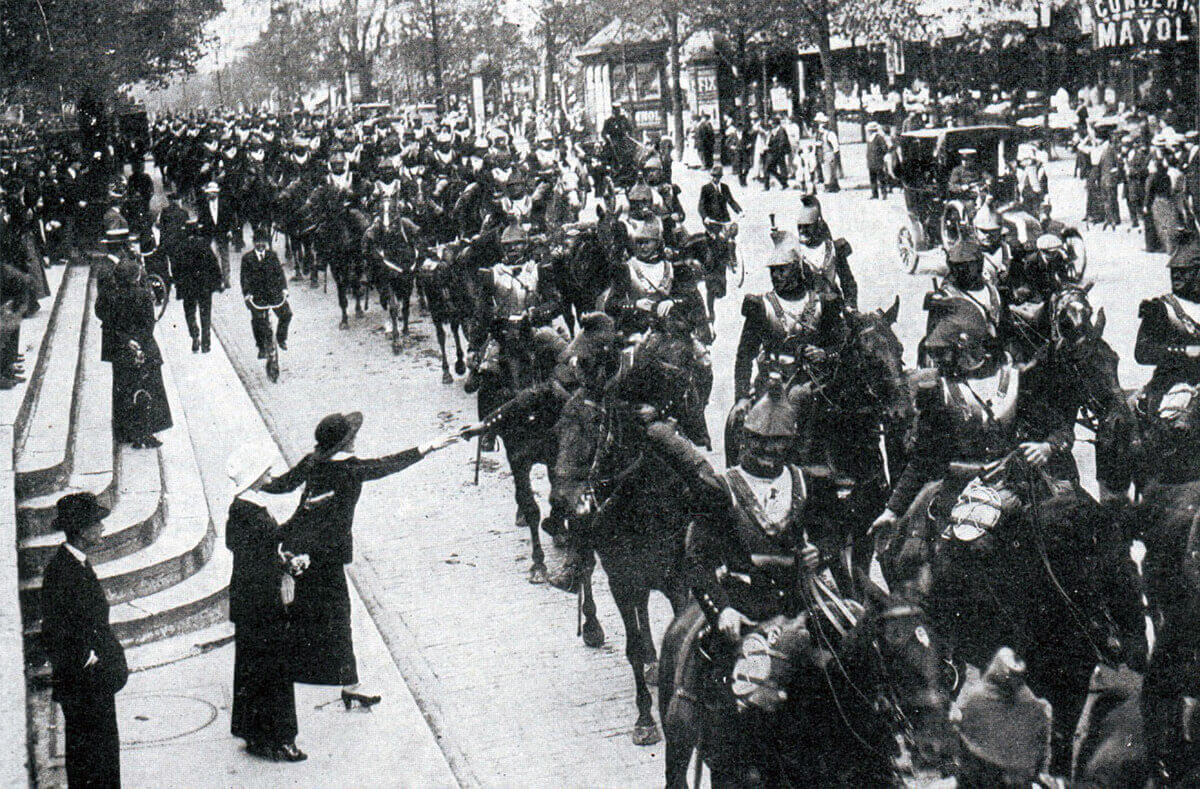
French cuirassiers passing through with Paris in 1914: the girl freehanded the flower is said to have been Island: Battle of the Marne, fought from 6th to 9th Sept 1914, during the World War I
5th September 1914:
In the aboriginal hours of 5th September 1914, General Joffre issued his operating instructions for the offensive. The French armies in the centre and on the right, in the line Confederacy-east from Verdun to the Swiss border, were to remain in that spot. The three armies connected the left were to come up the offensive; Manoury's French 6th Army and I Cavalry Army corps advancing from Paris, the British Military Force (BEF) forward north eastmost, and Franchet d'Esperey's French 5th Army advancing Union, to and across the Battle of the Marne and then on to the Aisne River.
The timing of the new order caused some difficulty. The BEF and some of the European nation 5th Army units were already subordinate way, marching out from the Germans, when Joseph Jacques Cesaire Joffre's instructions reached the senior headquarters. The retreating BEF formations were port to finish the Clarence Day's journey, and rest up, before returning over the ground they had just covered. Many of the 5th Army units could be and were halted during the Clarence Day.
At 9am connected 5th September 1914, General Manoury arrived at GHQ and explained to Landing field Marshal French his attack, to make up launched from a position west of the River Ourcq early the next day, 6th September. Sir John French promised the documentation of the BEF.
At 2pm, General Joffre arrived at GHQ and begged British support for the attack 'In the name of France'. Sir John French again promised that the BEF would do wholly information technology could in the operation.
6th September 1914:
The advance of the BEF began in the archaic hours of 6th September, bringing the BEF up to a line parallel with and a few miles south-west of the Grand Morin-Aubetin Rivers line. Atomic number 3 the units advanced, touch was made with powerful European country formations.
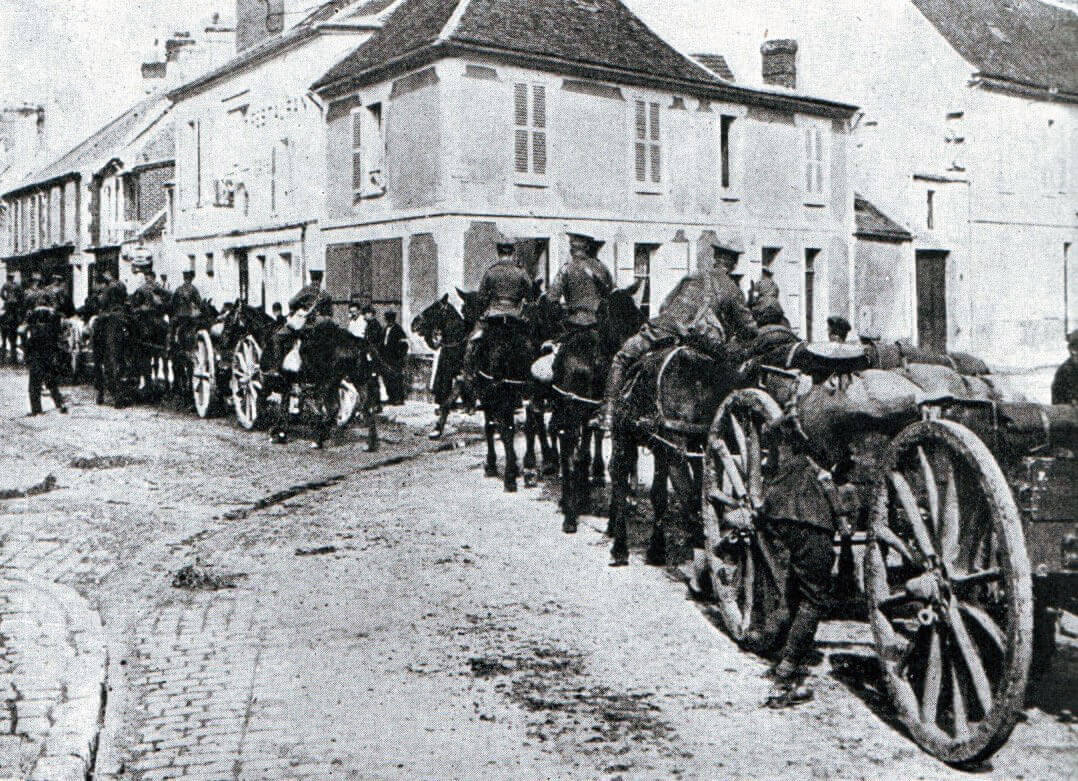
British transport during the advance to the Marne River: Battle of the Marne, fought from 6th to 9th September 1914, during the First Earthly concern State of war
The Island I Corps was coming up in the area of Rozoy, the 1st (Guards) Brigade finding themselves heavily engaged. General Haig halted I Corps while IT was determined whether the Forest of Battle of Crecy, to his front, was tenanted aside German formations.
The British II Army corps, on Haig's unexpended, reached the area around La Houssaye during the lately morning of 6th September, and the Island III Corps arrived at Villeneuve Le Comte at the same meter. These two corps, continuing their advance, caused the Germans to dawdle back, and I Army corps was enabled to summarize its possess cash advance.
Royal Flying Corps reconnaissance flights found that the British front was fair of German troops. Several of the German formations that had been engaging the BEF, were now deployed across the Ourcq River, facing General Galliéni's troops at the port end of the Allied rail line, on the northern side of meat of the Marne River.
The High German troops still facing the BEF were parts of II and IV Corps, and several cavalry divisions.
At 3.30pm, Sir John French ordered the three corps of the BEF to move forward to positions approximately 5 miles low of the Tremendous Morin River, betwixt Marolles and Crecy, with the Cavalry Division along the right flank, in the area south-west of La Ferté Gaucher.
Some of these orders were received too late for much make be ready-made that day.
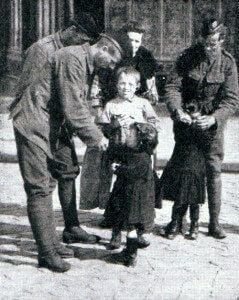
'Jocks' fraternising with European nation children during the advance to the Marne River
However in the British people II Corps area, in the centre, 7th Brigade of 3rd Division reached Faremoutiers, and at 11pm, 1st Wiltshires forced a crossing of the Grand Morin, seizing the heights of Lupus erythematosus Charnois, a mile north of the river.
By the end of operations for the twenty-four hour period, the advanced units of the British II and III Corps were along the Deluxe Morin River, piece I Corps and the Cavalry Division, on the decently, were still short of the Aubetin River.
Allied intelligence assessments put the High German Trine and Nina from Carolina Corps with the Guard Cavalry Division opposing the French 5th Army, to the east of the BEF, and parts of the German II and IV Corps, with the 2nd, 5th and 9th Horse Divisions, anti the BEF, in the area between the Grand Morin and Petit Morin Rivers.
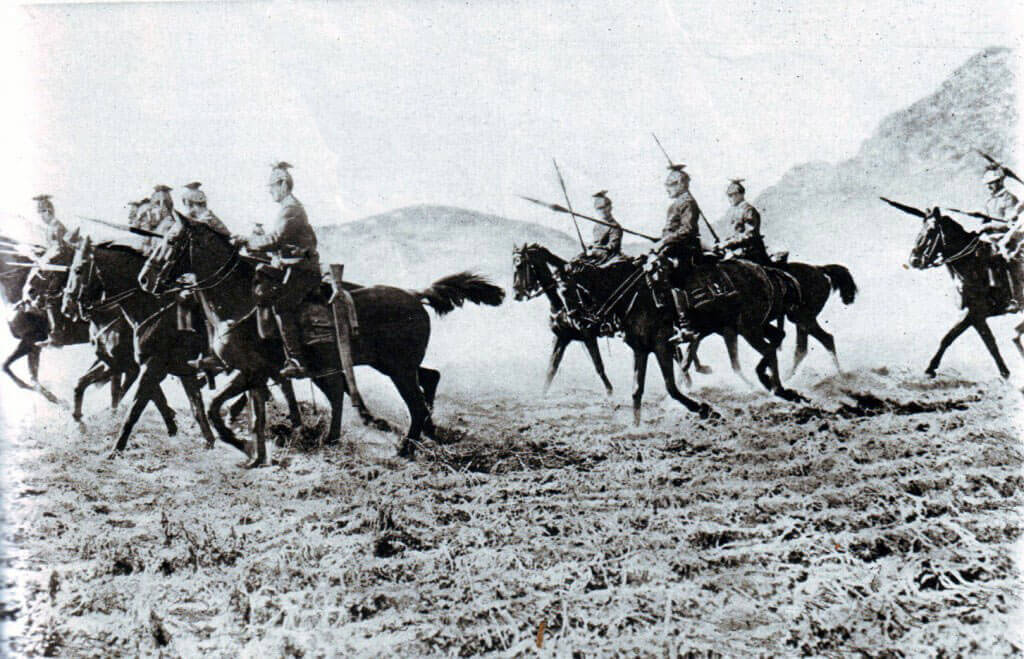
German language Uhlans advancing to the attack: Battle of the Marne, fought from 6th to 9th Sep 1914, during the First International Warfare
The French 5th Army was reported by the British air patrols to be pushing the Germans back, on the BEF's eastern flank. Similar patrols according that to the north-westbound, the French 6th Army was attacking the Germans on the westerly side of the Ourcq River.
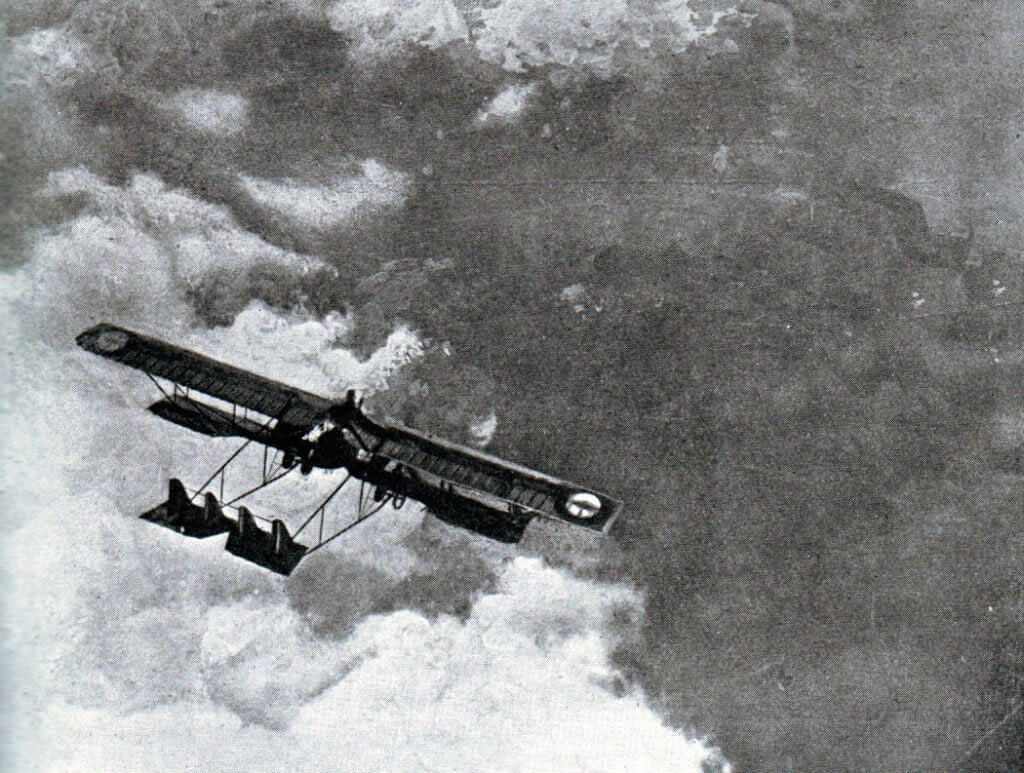
French aircraft: Marne Rive, fought from 6th to 9th September 1914, during the First World War
Sir John French issued no advance orders for the next day, other than that all units should be ready to move at short notice. During the nighttime the last of the casualty replacements reached the forward units from Britain.
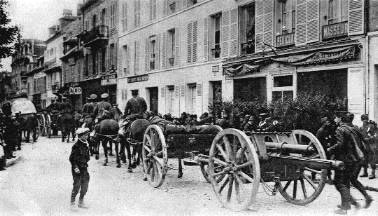
British Royal Field Artillery 18 Pounder Battery stimulating through a French Town: Battle of the Marne, fought from 6th to 9th September 1914, during the First Ma War
7th September 1914:
Late on 6th September, General Joffre, the French Commandant-in-Chief, issued a directive that the advance should be angled towards the North, rather than to the North-Orient, its direction on the previous day. This request did not reach the BEF HQ at Melun until late in the morning of 7th September.
The BEF units were on the move early in the day, the 5 cavalry brigades approach the Grand Morin River in the surface area in the south of a credit line from Coulommiers to la Ferté Gaucher.
The 9th Lancers moved into the town of Dagny, on the Aubetin River, leading 2nd Cavalry Brigade. The commanding officeholder of the 9th Lancers, Lieutenant Colonel Campbell, with his headquarters troop, was charged past a squadron of the German 1st Guard Dragoons. The covering machine gun forthwith jammed, leaving Colonel Joseph Campbell with no option but to meet the German squadron's charge. The lancers attacked at a full gallop, and the German horsemen, devising the charge at a clip, were overwhelmed.
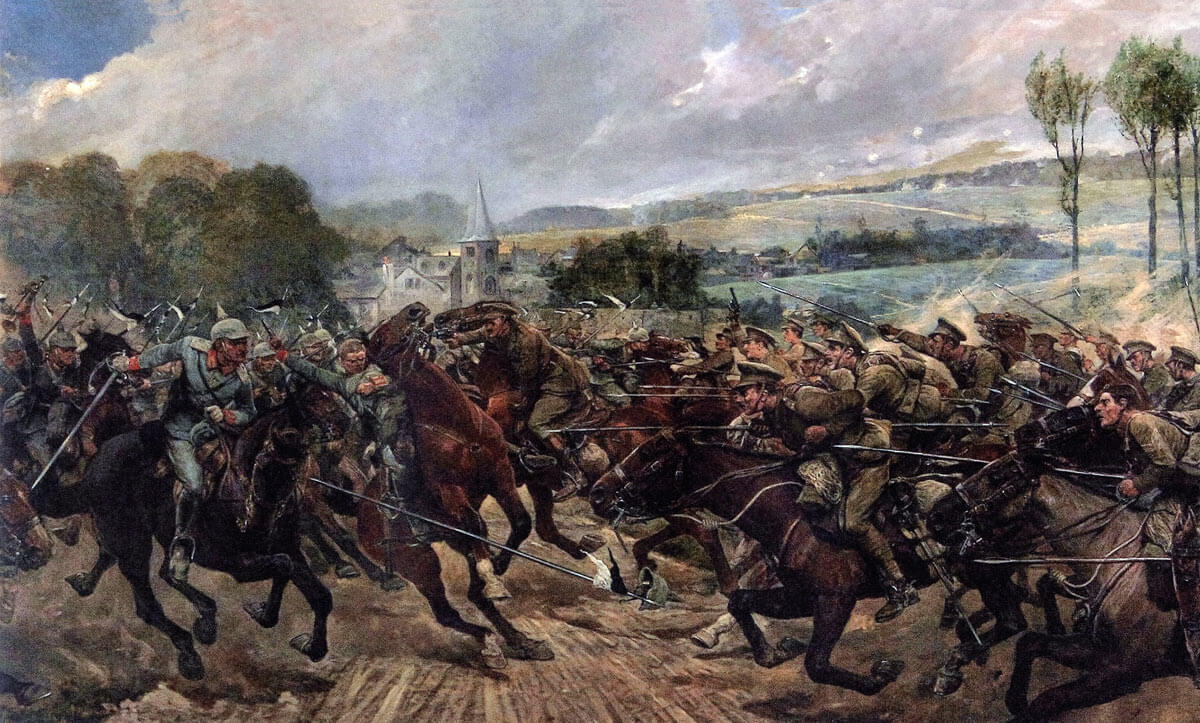
Light colonel Campbell charging the German squadron with his troop of 9th Lancers, happening 7th September 1914, during the Battle of the Marne, fought from 6th to 9th September 1914, during the First World War: picture by Richard Caton Woodville
Far to the right, a squadron of the 18th Hussars met a German cavalry tutelage with dismounted rifle fire, annihilating the attacking Germans.
At around 6am, the 1st Wiltshires were attacked in their positions in the north of the Grand Morin River, in the domain of Le Charnois, by deuce dismounted squadrons from the Guard Cavalry Division, which they drove off without difficulty. 2nd South Lancashires, coming aweigh in support, were engaged by German military personnel in the woods and suffered loss.
By 7am, cyclist and aeroplane patrols established that in that respect were no more some German units within 3 miles of the Grand Morin River in the area of Crecy. There were still substantial bodies of German infantry and cavalry to the north of the river at la Ferté Gaucher.
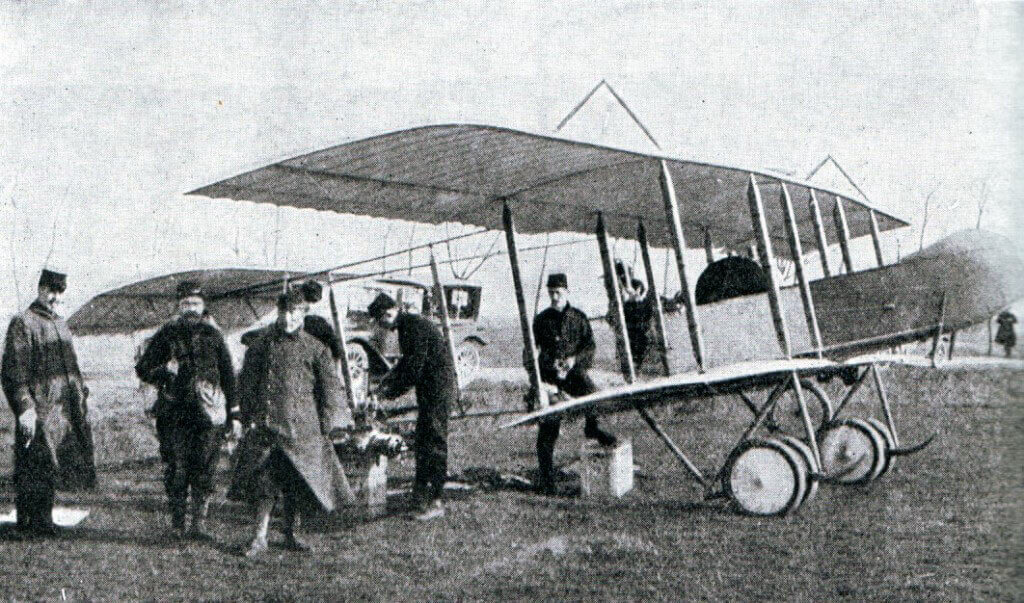
French aircraft beingness repaired in the field: Engagement of the Marne, fought from 6th to 9th September 1914, during the Beginning World Warfare
At 8am, Sir Saint John French ordered the BEF infantry army corps (I, II and III) to advance north east in the steering of Rebais, partially crossing the Grand Morin River, and halt on the line Dagny-Coulommiers-Maisoncelles, for further orders.
The Cavalry Division secured the feed of the Grand Morin River as far east as la Ferté Gaucher, and so pushed on to Rebais. The 3rd Horse cavalry Brigade advanced on Coulommiers, meeting underground at the river crossing, and bringing its guns into action. Onward along the road to Doue, 3rd Cavalry Brigade was halted by High German infantry and machine gun blast.
The British people infantry advanced behind the cavalry blind, and encountered clear signs of a disorderly pull away by the German troops. Large numbers of empty bottles lay around the villages, and four incapably drunk German soldiers were establish in a hayrick near Chailly, by a driver from 48th Battery RFA collecting feed for his horses, who took them prisoner.
On the eastern flank, General Haig brought the correct of I Army corps upward to the Grand Morin River, to make contact with the French 5th Army.
The 7th September saw the BEF make headway around 7 to 8 miles, ending the day with its formations along the Grand Morin River, much along the south bank and several on the north, from lah Ferté Gaucher west to Maisoncelles.
The French 5th Army to the east of the BEF, lay aside along the Grand Morin River, again on the due north and south banks. The French 6th Army, to the north-Mae West of the BEF, was within 5 or 6 miles of the Ourcq River, with the European nation formations opposed to it falling back to the Orient of the Ourcq.
Sir John French issued orders for the next day's advance to the Petit Morin River and then on to the Marne River.
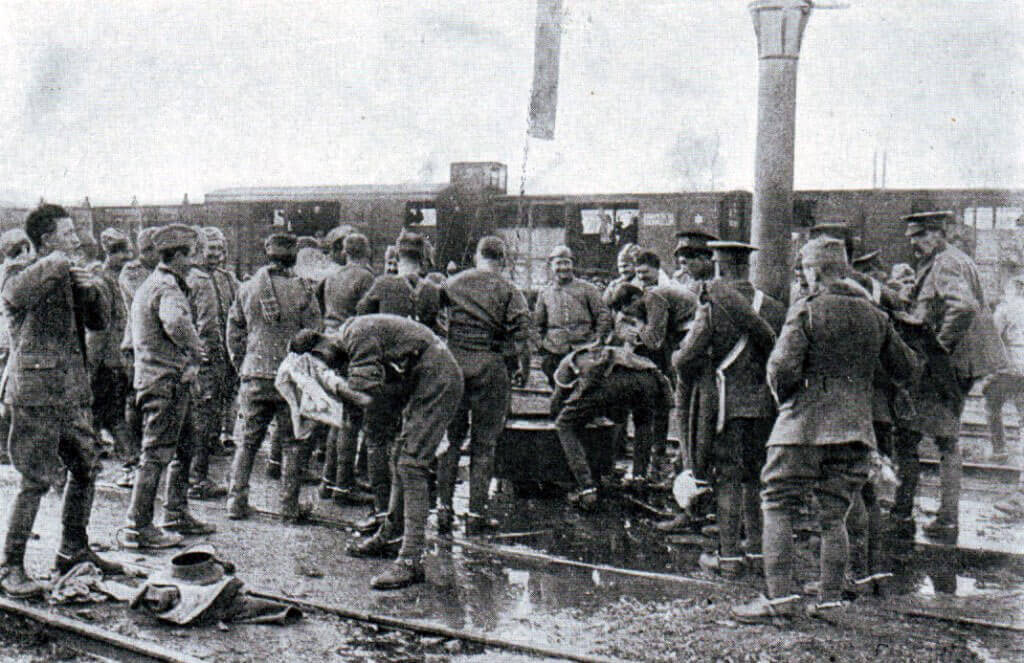
British soldiery washing in a French base: Chateau-Thierry, fought from 6th to 9th September 1914, during the First World War
8th September 1914:
Happening 8th September, von Kluck ordered his commanders to make a stand on the Petit Morin River, in the expected value that his II Corps could repel General Manoury's French 6th Army happening the Ourcq River to the N-Rebecca West, and General Bülow could toss back the Gallic 5th Army.
The Brits Cavalry Division moved proscribed at 4am on 8th September, covering the I and II Corps, heading for the Petit Morin River, directly north from Pelican State Ferté Gaucher to Sablonnières.
The 4th and 5th Sandbag Guards LED the 1st and 2nd Cavalry Brigades into the vale of the Petit Morin, and attacked the bridges over the river. Both were held up by dismounted cavalry military personnel holding barricades along the bridges and in the close houses.
The 3rd and 5th Cavalry Brigades, under Brigadier Gough, operating severally, came up to the Petit Morin River to the west of the Cavalry Division.
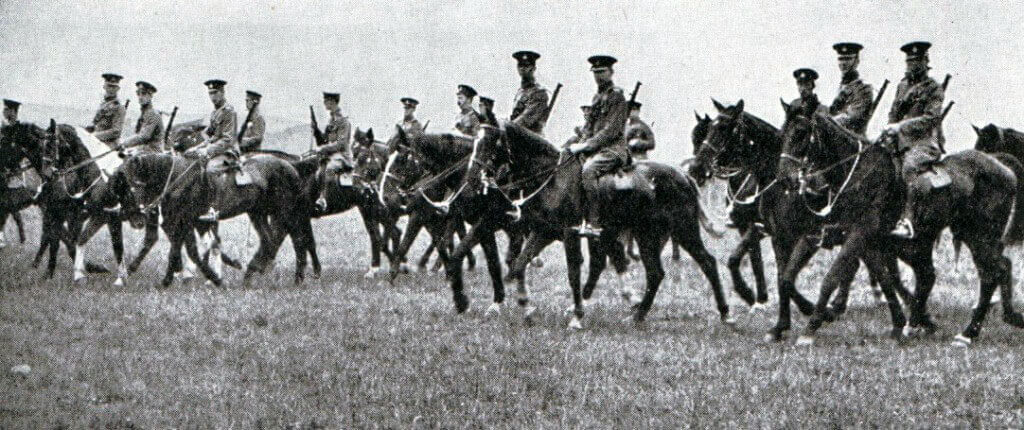
British cavalry in 1914: Chateau-Thierry, fought from 6th to 9th September 1914, during the War to End War
The Royal Scotch Greys came upon a German horse cavalry brigade eating its breakfast in the oddly called village of Rock of Gibraltar. A division of J Battery RHA came into action, and dispatched the High German brigade back across the vale.
German counter-attacks and supporting artillery fire brought the come on of the British horse to a halt away around 8.30am, leaving the Germans in put down along the Petit Morin River.
Further west, at la Ferté sous Jouarre, the German 5th Infantry Part was pulling back crossways the Marne River, at the point where the river joins the Petit Morin River, the southerly bank being held by the German 2nd Cavalry Division and four Jӓger battalions. Substantial German positions rudder-like a semi-circle in the hills to the north of Pelican State Ferté sous Jouarre.
To the west of Louisiana Ferté sous Jouarre, from 6am, the British 12th Brigade of 4th Division and the independent 19th Brigade, both of III Army corps, advanced into the Marne vale, clearing the wooded countryside of bodies of German troops in the process.
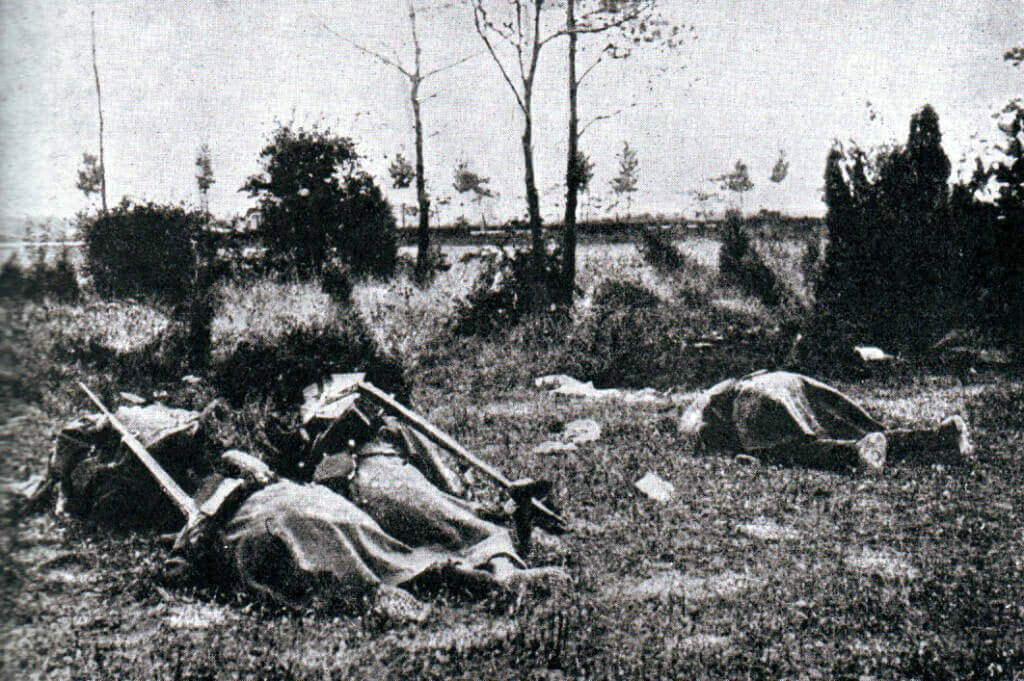
German casualties from motorcar gun fire: Engagement of the Marne, fought from 6th to 9th September 1914, during the First Ma War
The 19th Brigade affected onto the ridge above the Marne, and came under cannon fire from crossways the river. Cardinal Island batteries returned this fire, but it was clear that it would take a substantial assault to track the Marne in the face of the German soldiery defensive the northerly camber, and those occupying la Ferté sous Jouarre.
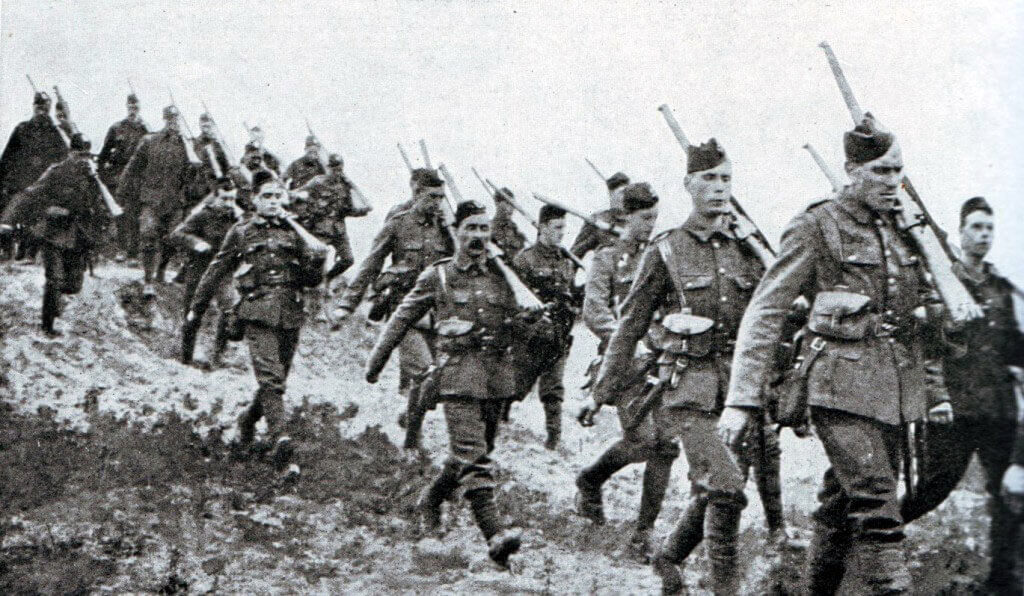
1st Cameronians of the British 19th Brigade advancing during the Battle of the Marne, fought from 6th to 9th September 1914, during the First Ma War
At the eastern end of the BEF line, 1st Black Watch (of 1st Guards Brigade, 1st Variance, I Corps) and 117th Battery RFA advanced to Bellot at 9.30am, and pushed across the Petit Morin River, in the face of heavy German artillery fire, with the support of 118th and 119th Batteries RFA and power-assisted past European country cavalry.
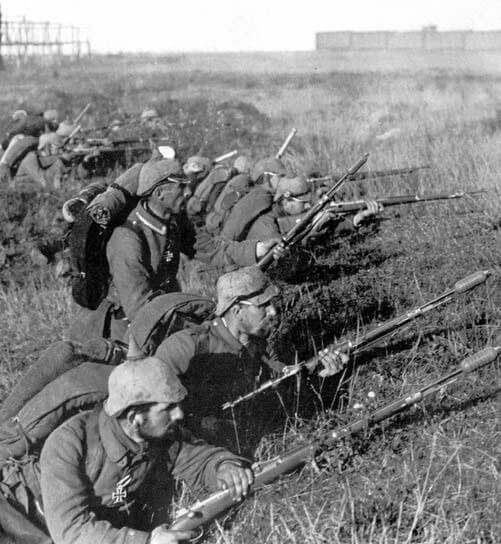
German infantry awaiting an attack during the Battle of the Marne, fought from 6th to 9th September 1914, during the First World War
Once over the Petit Morin River, the Black Catch mature north west along the north bank of the river to attack the Germans in Sablonnières. They were strongly resisted by dismounted German horse cavalry and the Garde Jӓger, and, only joined in the onset by the 1st Queen's Have Cameron Highlanders and dismounted cavalrymen, did the attack make build, ensuring the capture of Sablonnières by 1pm.
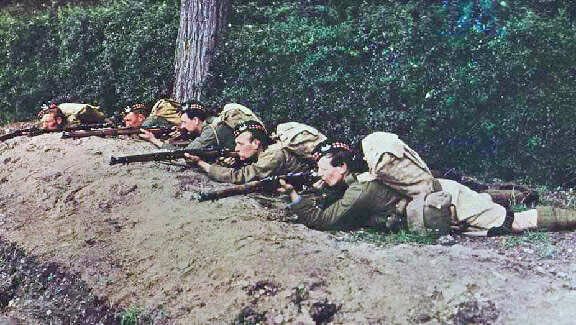
Highlanders during the Fight of the Marne, fought from 6th to 9th September 1914, during the World War 1
Further to the west along the Petit Morin River, Foot Guards battalions of 4th Guards Brigade (2nd Division), 1st Irish Guards, 2nd Grenadier Guards and 2nd Coldstream Guards, with 2nd Worcesters of 5th Brigade, mounted an attack on a number of Harry Bridges in the area of la Trétoire, supernatant by three brigades of RFA and a overweight battery, against strong European nation infantry and car gun fire, supported by artillery batteries positioned on Capitol Hill line commanding the Petit Morin River. The fighting was confused and heavy reliance placed along the initiative of secondary officers and soldiers. The British foot forced a crossing of the river, enabling British cavalry units to cross and causing the Germans to lapse.
A party of Irish Guards captured a Guard Machine Gun company with 6 machine guns.
At around 4pm, 47th (Howitzer) Battery RFA came into carry out north of the Petit Morin River. The battery was fired on by German infantry in the woods. The gunners socialist their guns and attacked the German infantry with rifles, driving them back, and capturing 9 German soldiers.
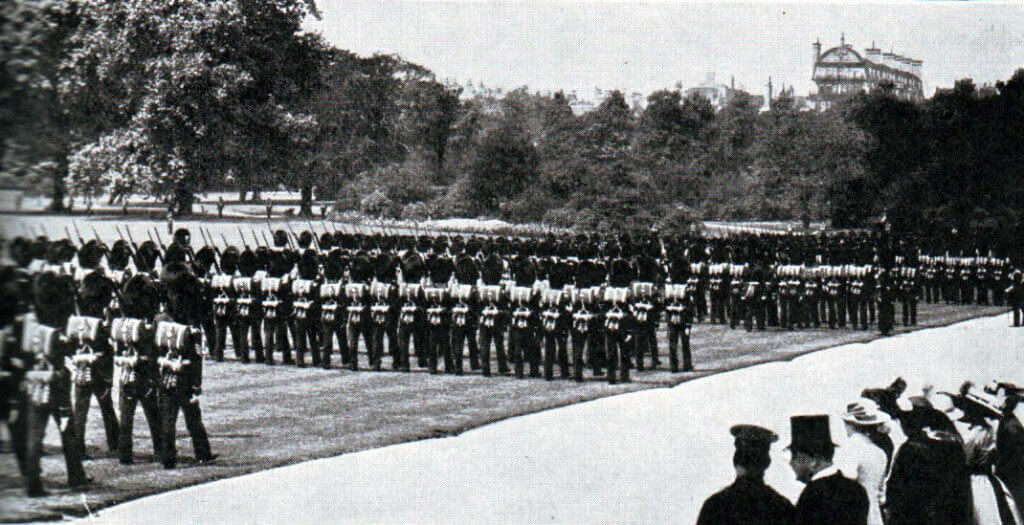
Irish Guards earlier the War: Battle of the Marne, fought from 6th to 9th September 1914, during the First World State of war
To the west of I Corps, the divisions of II Corps faced distressful German opposition in attempting to cross the Petit Morin River.
The Brits 5th Cavalry Brigade and the 8th Infantry Brigade attacked the Germans at Gibraltar, but could make no progress, easily obscure German machine guns connected the rising north side of the river continuing to hold upfield the tone-beginning, in spite of all-inclusive British cannon fire.
Further west on the Petit Morin River, at 9am, the British 13th Infantry Brigade, 121st Battery RFA and the 3rd Cavalry Brigade attacked at St Cyr, just were held up by fire from German artillery dark on the north side of the river.
On its right hand flank, the 14th Infantry Brigade made its advance to the Petit Morin River from Doue, to the full stop opposite St Ouen. Hither, the offensive battalions, 1st Duke of Cornwall's Light Infantry and 1st East Surreys, were confronted by a heavily wooded steep slope drink down to the river, which disunited into two streams, some streams intercrossed past a long single bridge circuit, covered by two European country auto guns positioned on the ridge to the north of the Petit Morin River.
The two British battalions managed to cross, by a encourage pedestrian keep going one stream, and a ford and gravy boat over the other. Once ended, the East Surreys outflanked the German positions and pushed them back. The DCLI moved along the river and captured St Cyr, enabling the British advance to continue.
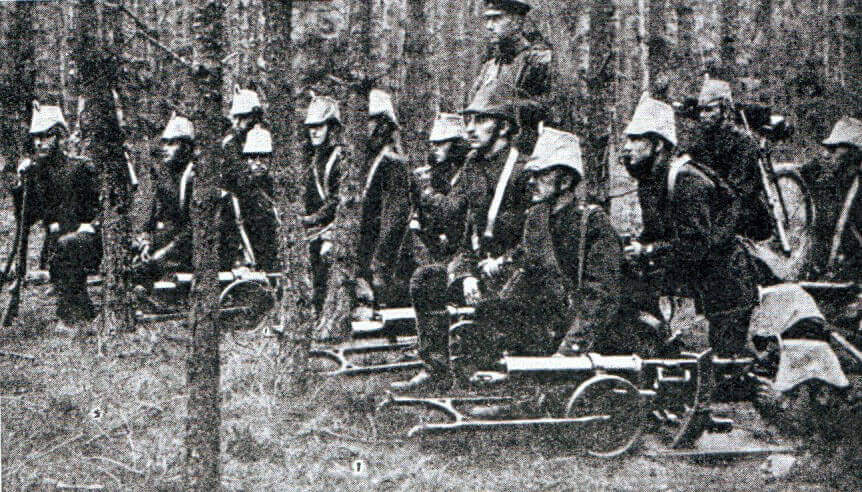
German Garde Jäger automobile gunners: Marne Rive, fought from 6th to 9th Sep 1914, during the First World State of war
European country units, 11th Cavalry Brigade and Garde Schützen, remained on the Petit Morin River at Orly, to the east of St Cyr, not having standard the rank to withdraw.
2nd Oxford University and Bucks Light Infantry and 2nd Connaught Rangers were approaching Orly, afterwards crossing the Petit Morin, and 4th Guards Brigade were on the independent touring from Montmirail to Louisiana Ferté sous Jouarre, in the rear of the Germans in Orly.
The British 60th Mortar Battery opened fire on the Germans behind Orly, drive them rearwards towards the main road, where they suffered expectant casualties at the work force of 4th Guards Brigade. Orly was taken soon after, past the converging 8th and 9th Brigades, down at around 4pm.
La Ferté sous Jouarre was the key townsfolk on the left of the Island advance, with a number of bridges over the Petit Morin and the much big River Marne, the two rivers meeting in the township.
The guns of the British 4th Division began shelling German positions and artillery in la Ferté sous Jouarre at around noon, assisted away 108th Heavy Battery from 5th Variance, firing polish off the map from Doue.
At 1pm the British 11th, 12th and 19th Brigades attacked la Ferté sous Jouarre, and, in spite of the demolition by the Germans of the two bridges terminated the Petit Morin, the part of the town south of the Marne River was taken aside 8pm.
A violent thunderstorm at around 6pm severely handicapped boost trading operations for the BEF, and they came to a private, leaving Brits units across the Petit Morin, and, in some instances, well on their way to the Marne River, the next obstacle in the advance to the north.
The main German formations facing the BEF, I Horse Army corps and parts of IV and IX Army corps were retreating to the Marne, and forming positions behind that wide river.
On the precise of the BEF, the Daniel Chester French 5th Army successful good progress during the day, and stood to the north of the Petit Morin. Happening the British left, General Manoury's French 6th Army was encountering difficulty dealing with the strongly reinforced German formations along the Ourcq River, and was in some places unexpected back.
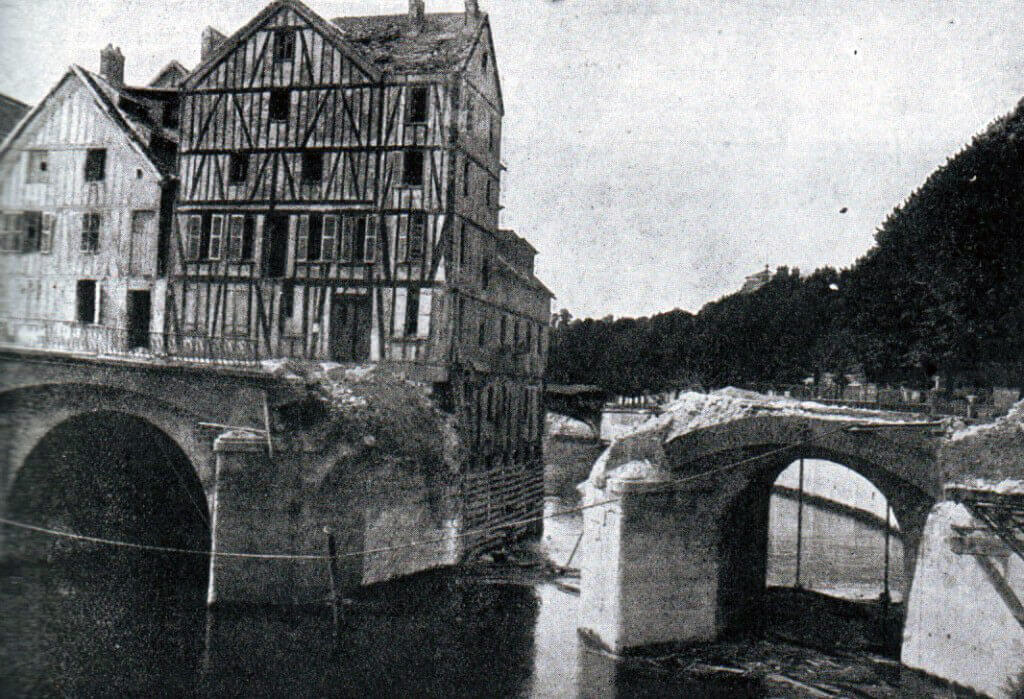
Pont du Moulin at Meaux happening the Marne River, demolished by European nation sappers: Marne Rive, fought from 6th to 9th September 1914, during the Introductory World War
9th September 1914, the Passage of the Marne River:
The orders for the BEF, on 9th September 1914, were to crush forward from 5am. The expectation was that the Germans would fight on the line of the Belleau Wood. The Marne was much wider than the rivers encountered during the advance over the previous few years, and the insurrection hills on the north bank were ideal for infantry positions and concealing artillery. A couple of Harry Bridges crossed the Marne and these could be destroyed.
The numbers of German troops concentrated along the north bank of the Marne seemed to bear out this judgement.
Still, air reconnaissance by the Royal Flying Army corps during the evening of 8th Sep suggested that the Germans were continuing to withdraw, rather than offering a strong defence along the line of the Marne.
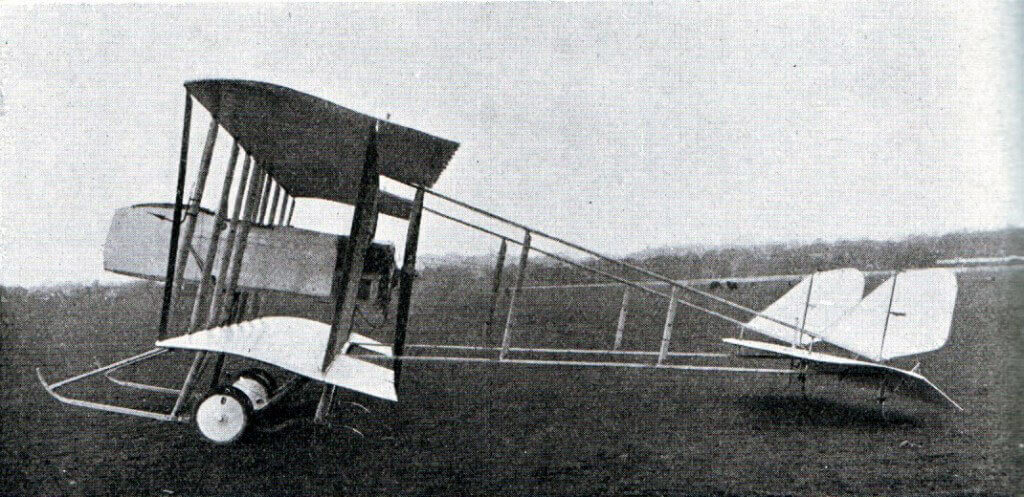
Maurice Farman 'Gun Bus': Battle of the Marne, fought from 6th to 9th Sept 1914, during the First Universe War
The Germans demolished the bridge over the Marne at la Ferté sous Jouarre and two Harry Bridges to the west, but not the bridges inverse the centre of the BEF advance. It would look that this was imputable incompetence.
The 6th Infantry Brigade approached the bridge at Charly. It could be seen that there was a barricade across the middle of the bridge, but no German soldiery holding it. A platoon of 1st Rex's Liverpools approached and crossbred the bridge, dismantling the barricade. The locals rumored that the Germans responsible for destroying the bridge had become incapably drunk instead. The umteen incidents of drunkenness indicated a breakdown in German discipline.
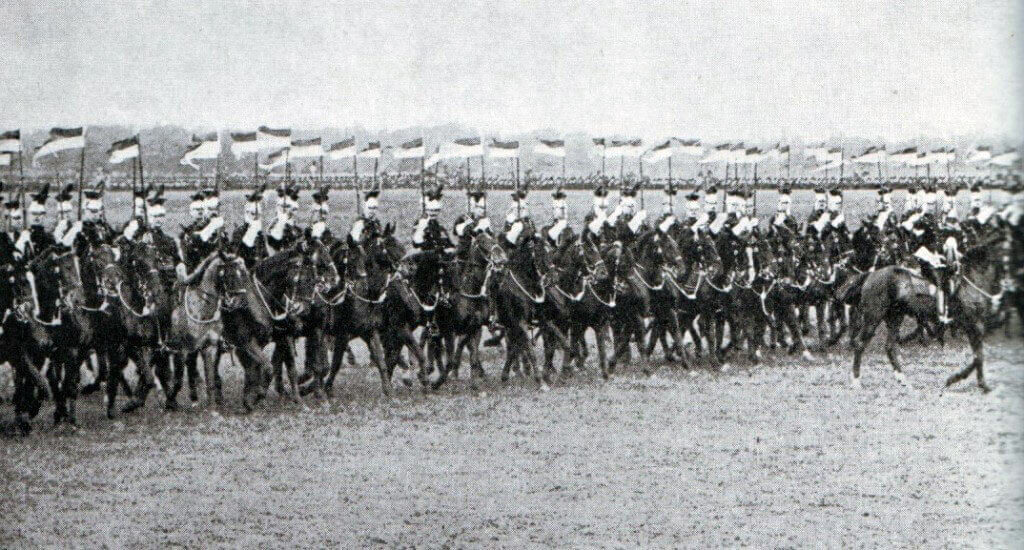
The British 5th Lancers in review at Aldershot before the war: Marne Rive, fought from 6th to 9th September 1914, during the First World War
By 5.30am, the British 1st Horse Brigade secured the bridgework at Nogent, and the 4th Cavalry Brigade secured the bridge at Azy, both intact. These two brigades advanced a promote three miles to provide cover for the British infantry crossing the Marne River.
Units of the British 1st and 2nd Divisions crossed the Marne in that sector and moved north, ahead being halted, connected the receipt at GHQ of entropy that brawny German forces were moving in from Château Thierry, promote east on the Marne. In fact, thither was no more formed body of German soldiery, just humble parties and columns, all moving northeastward.
At 3pm, British RFC aircraft reported the surface area clear of German formations and I Army corps resumed its advance up to the Château Thierry to Montreuil road. Sir John French ordered I Corps to stop there, as the French 5th Army on the word-perfect was not making an equivalent progress, and was decreasing bum the British advance.

The Royal Flying Corps on parade in 1914 before the State of war: Battle of the Marne, fought from 6th to 9th September 1914, during the First gear World War
To the west of the Island I Army corps crossway points, but eastbound of La Ferté sous Jouarre, the Germans remaining bridges at Nanteuil and Saacy undemolished, and available for II Corps' use. By 8am, the 3rd Division was crosswise the Marne at Nanteuil, and the 5th Part was also across and attacking the heights to the north of Saacy, against heavy German immunity. This resistance, coupled with the close wooded countryside, held awake the advance by the14th Brigade towards Montreuil.
West of Bezu, some miles north of the Marne River, the advanced guard of the British 3rd Division came low-level lasting shrapnel fire from a German battery concealed in a wooded area.
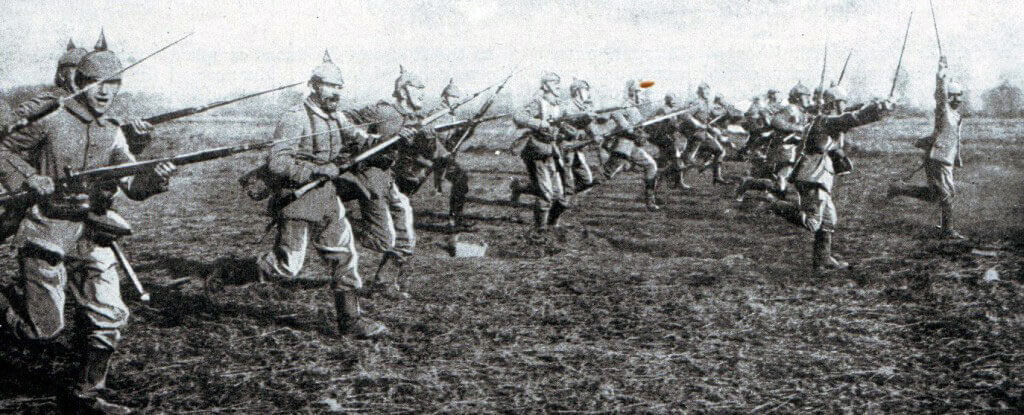
German infantry attack: Battle of the Marne, fought from 6th to 9th September 1914, during the First World War
Two companies of the 1st Lincolnshire Regiment advanced through the wood to shut up the German guns, A battery of the German 46th Field Ordnanc Regiment. The Lincolns crept to inside 150 yards of the German guns, and shot down the gunners to a man. Advancing to take the guns, the Lincolns came under fire from the German gun escort, which they overcame, and from the Brits 65th Howitzer Battery, misunderstanding the British infantry for backward Teutonic gunners. The Lincolns suffered hefty casualties from the British gun fire, and were unvoluntary to withdraw into the wood. The German guns were captured the following day.
At around 11.30am, the British 3rd Air division emerged from the close thicket-forming domain, and launched attacks on the German positions approximately Montreuil. Heavy belligerent took place, the Germans supported by gun batteries situated on each side of the town, and the assault away the 14th Brigade on Montreuil was brought to a halt.
Attacking Montreuil from the south-east, the British people 15th Brigade was halted by sullen simple machine gun fire and sneaky European country guns. At around 6pm, a German battery at Chamoust was discovered, and extend of natural action past the British 37th Trench mortar Barrage fire, but it was now too of late to make boost progress before nightfall. In addition, 3rd Division found that the units on its flanks were still well back, so, differently ambitious a vanguard onto the Château Thierry to Montreuil road at Ventelet Farm, the division remained where it was, in the most advanced position of the BEF II Corps on the north side of the Marne River.
During the day, the British Leash Corps unsuccessful to cross the Marne River along the stretch of river running north east to southmost west, forming the westernmost side of the grummet, on the east side of which the 3rd Sectionalization was advancing on Montmireuil. The only bridgework in stock was the railway bridge towards the northern end of the loop, the others being damaged by German demolition. The strong German positions on the magnetic north side of the Marne were covered by artillery from the area of Montmireuil, firing into the III Corps right flank, and further batteries directly in the German rear.
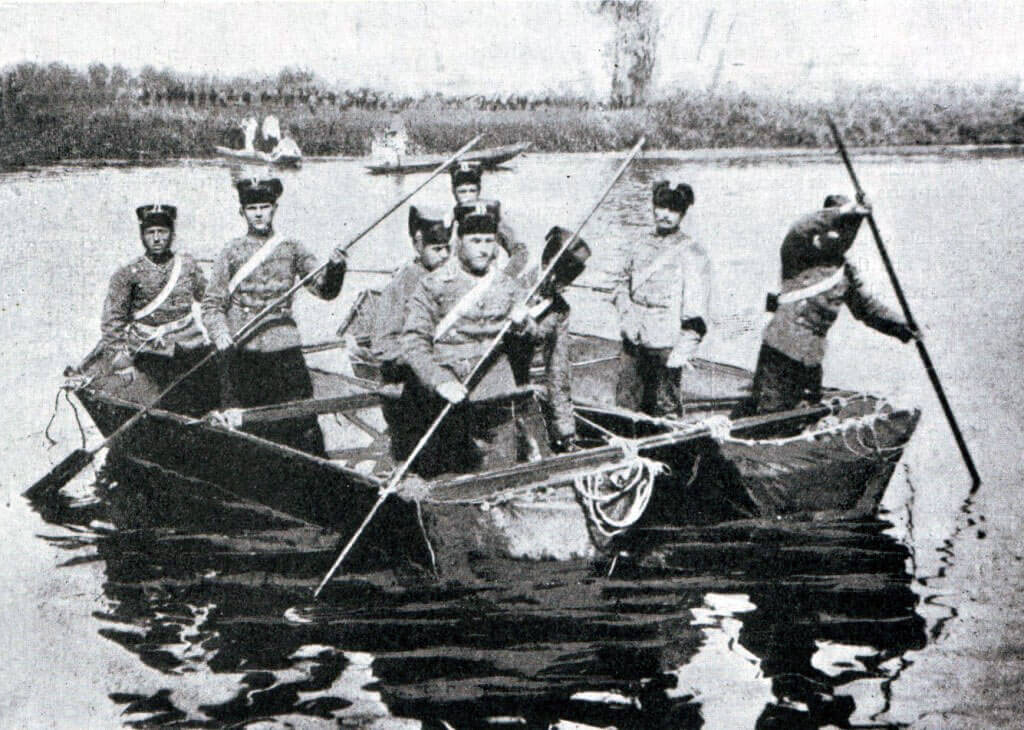
German Hussars crossing a river: Battle of the Marne, fought from 6th to 9th Sept 1914, during the First World War
The pontoons available to the Head of state Engineers of Deuce-ac Army corps were skimpy to cross the wide Marne River. The pontoon companies washed-out the daylight collecting additional material to complete the river span.
At 4.45am along 9th September, the British 11th and 12th Brigades launched assaults into and around Louisiana Ferté sous Jouarre, with orders to compensate and queer the marred bridges. This proved extremely difficult, equally the Germans in use some of the encompassing buildings. British artillery busy the high priming to the east of la Ferté sous Jouarre, and began bombarding the houses identified as holding German political machine guns and infantry. Attempts were also made to cross the Marne by gravy holder to the western United States of lanthanum Ferté sous Jouarre. These attempts failing, in the face of strong German simple machine gun, artillery and rifle fire.
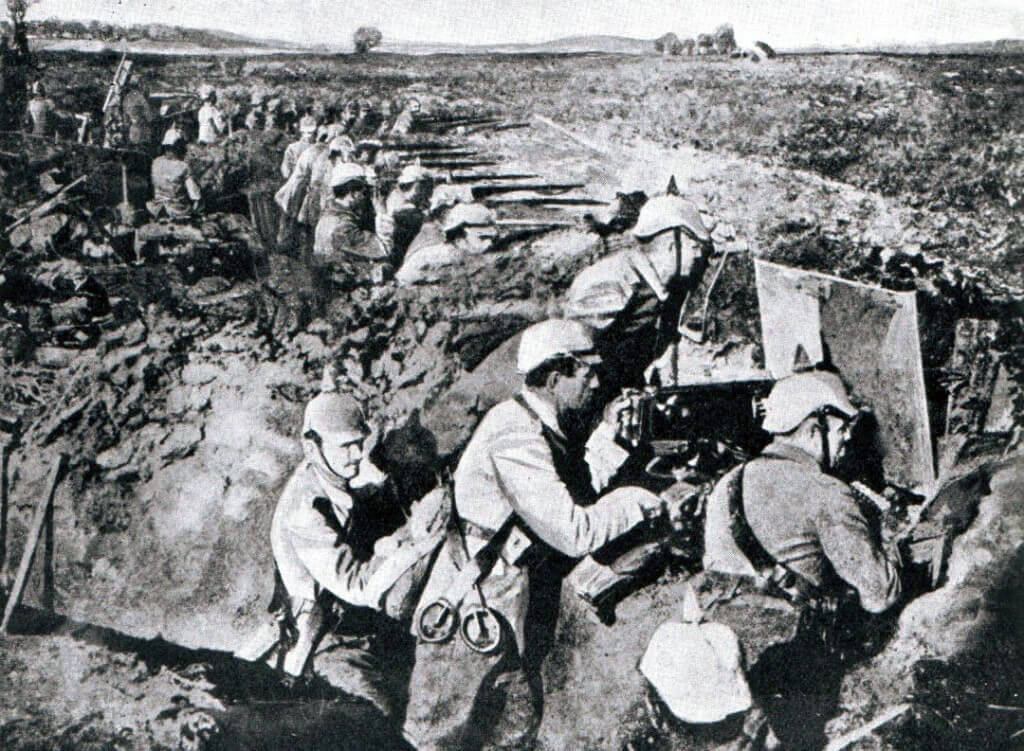
German infantry during the Chateau-Thierry, fought from 6th to 9th September 1914, during the Number 1 World State of war
Two battalions of the British 12th Brigade, 2nd Essex Regiment and 2nd Lancashire Fusiliers, advanced up the river bank into the intertwine, to a weir known from the maps. They found a lock, barrage and weir defended past Germanic infantry, but intact. The German infantry were driven disconnected by small weapons system and car artillery fire, and the British hybrid the weir footbridge in single file, most without casualty.
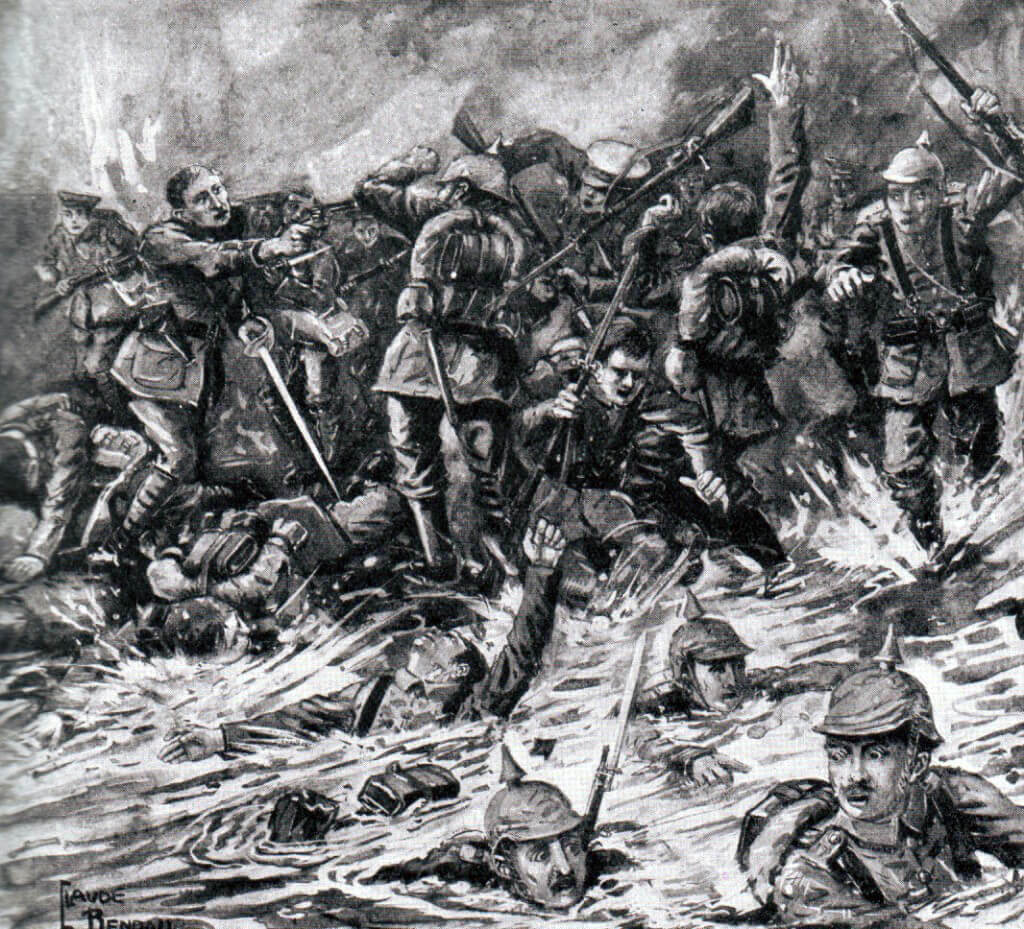
Contemporary illustration of fighting on the Marne River, with the legend 'We killed them on the deposit then we drowned them in the river': Fight of the Marne, fought from 6th to 9th September 1914, during the First World State of war
The two Brits battalions spoon-shaped finished, and climbed the hill to the road from la Ferté sous Jouarre to Montreuil, but arrived too late to bug the German retreat from la Ferté sous Jouarre.
In the meantime, the British 11th Brigade withdrew from la Ferté sous Jouarre and the town was subjected to an extensive bombardment, causation the Germans to abandon the defence of the bridges. These were inspected and repairs begun.
Past evening, troops of the British Ternary Army corps were crosswise the Marne, away boats to the west of la Ferté sous Jouarre, by way of the Harry Bridges in the town, and over the weir and aside the railway bridge further northwest in the loop.
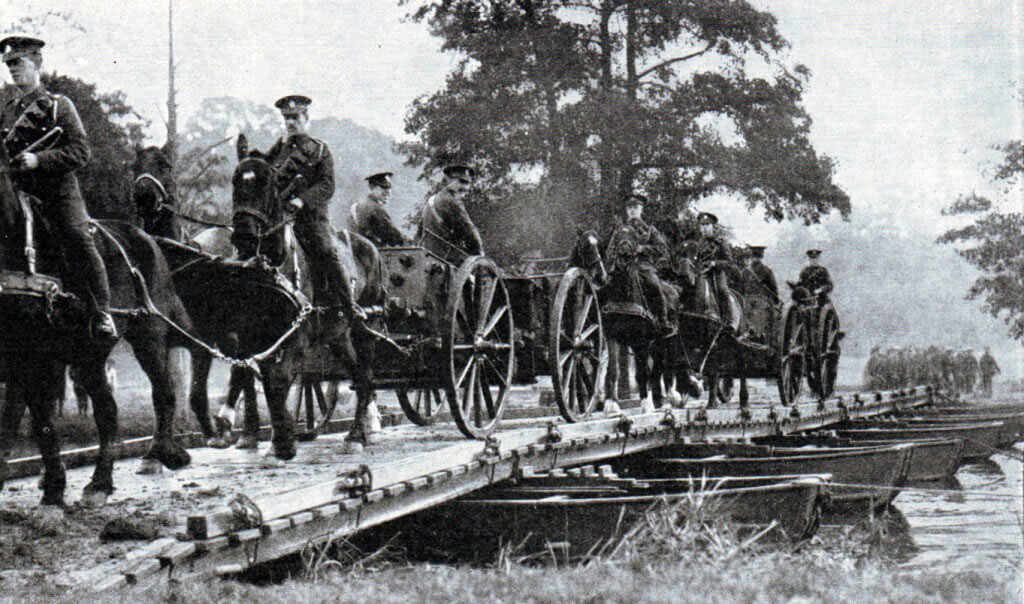
British troops hybridization a pontoon bridge in 1914: Battle of the Marne, fought from 6th to 9th September 1914, during the Eldest World Warfare
At the end of 9th September 1914, the British Military Force occupied positions northwar of the Marne River. The Cavalry Division repose around Lucy le Bocage on the right, the most advanced of the Brits formations. 5th Cavalry Brigade put off at La Baudière, honorable west of the Cavalry Division. I Corps had advanced to a line from Le Thiolet to Couprus. II Corps lay from Bezu to Caumont. 3rd Cavalry Brigade was still south of the Marne. III Corps lay betwixt Luzancy and Chamigny.
By around 5.30pm, melody reflection showed that the German First and Second Armies were carrying out an all-encompassing withdrawal on the fronts held by General Manoury's French 6th Army, the BEF and General Franchet d'Espèrey's French 5th Army to its right.
The Battle of the Marne was ended and the Battle for the Aisne about to begin.
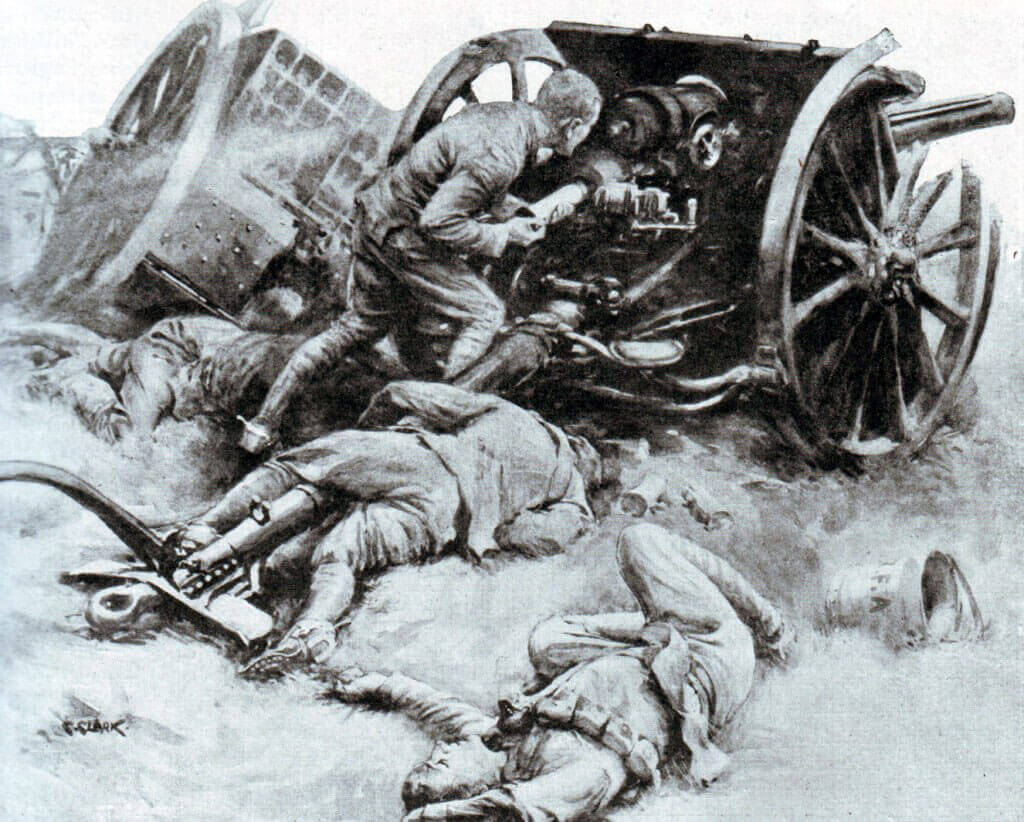
British people 18 pounder in military action in France 1914: Battle of the Marne, fought from 6th to 9th Sept 1914, during the First World War
Casualties at the Chateau-Thierry: The casualties of the BEF for the whole state of war up to 10th September 1914 were 12,733. The casualties in the advance to the Marne during the period 6th to 10th September 1914 were 1,701. The French lost around 250,000 men in the flow of the warfare up to 10th September 1914. German casualties for this period are unknown, but are likely to have been like-minded to the European country. The BEF captured 13 guns, several machine guns (7 were taken by 4th Guards Brigade from the German Garde Jӓger on 8th September 1914) and 2,000 European country troops.
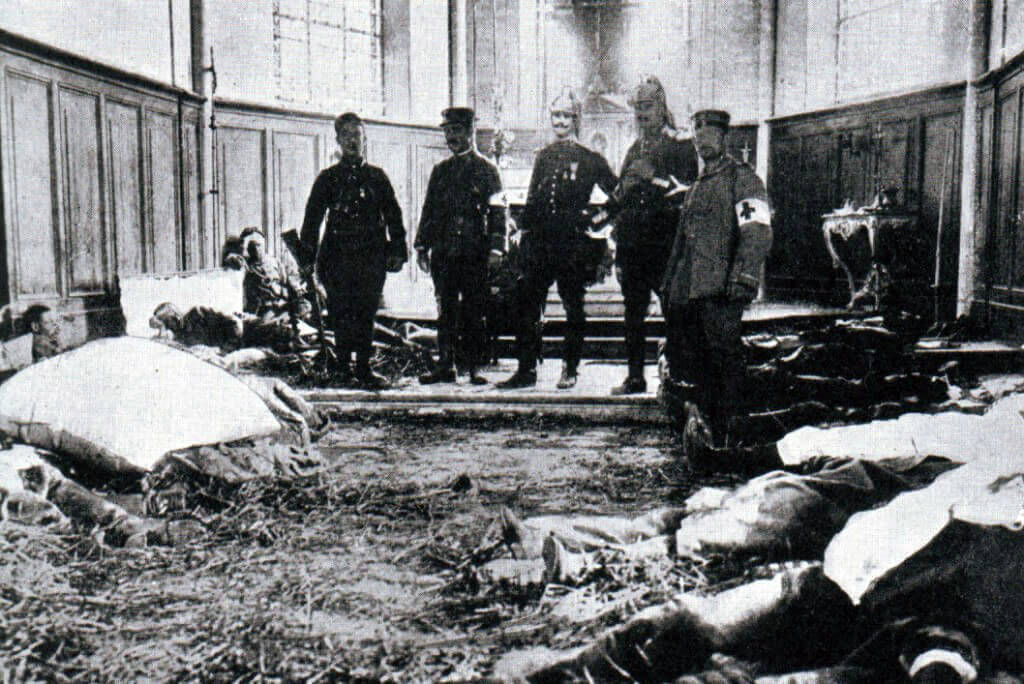
Church building just about Meaux, utilised as a hospital for French and German casualties: Battle of the Marne, fought from 6th to 9th September 1914, during the First World War
Aftermath of the Battle of the Marne: The Struggle of the Marne byword the German attempt to steam tumbler the French and British armies, and win the war in a month signally fail. As an alternative, the German USA was forced to fall back a considerable distance to the line of the Aisne River, broadly the line between the opposing sides until early 1918. General von Moltke was secretly remote arsenic High German Primary of Staff.
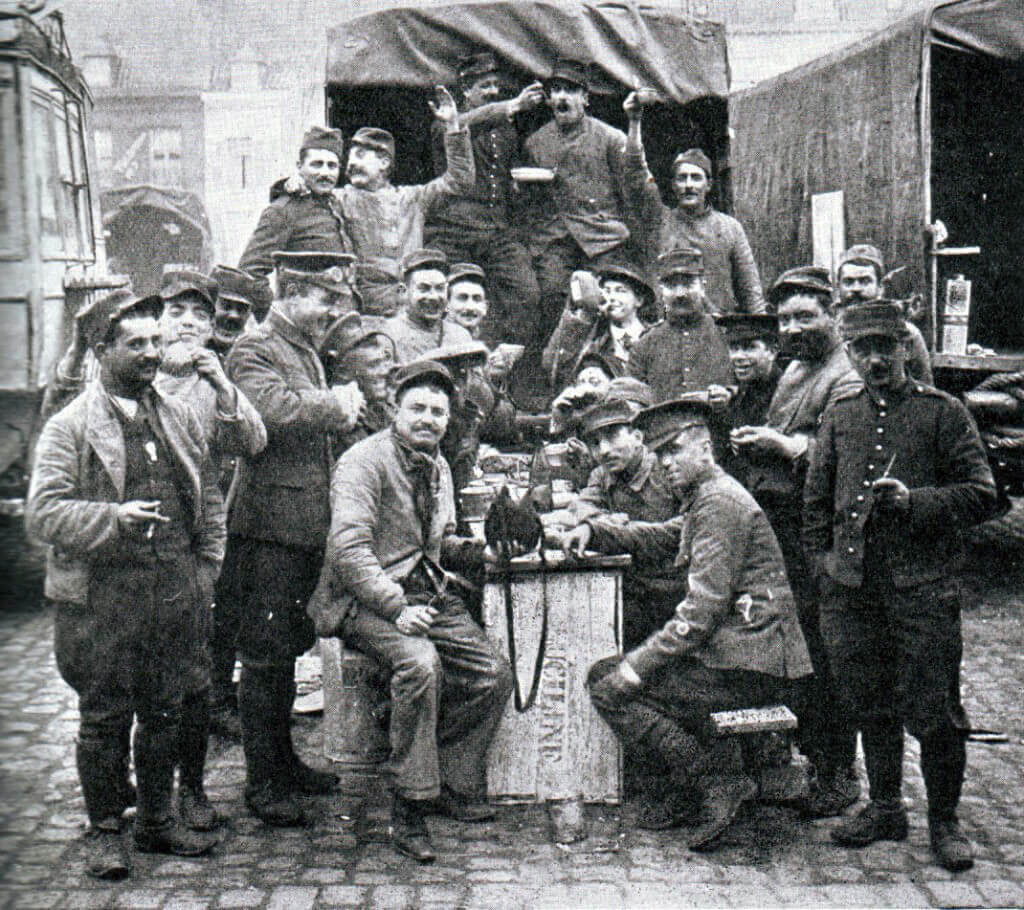
Brits and French troops during the Battle of the Marne: Conflict of the Marne, fought from 6th to 9th September 1914, during the World War 1
Decorations and campaign medals for the Chateau-Thierry: see the ingress for the Battle of Mons.
Anecdotes and traditions from the Battle of the Marne:
- It is hard non to admire the dash and resourcefulness of the BEF's units during the Battle of the Marne, in contrast to the poor esprit de corps and inefficiency of the hitherto successful German Army.
- One of the companies at the Royal Military Academy Sandhurst is named 'Marne Company', in appropriate acknowledgement of a star British victory.
- A letter written by a dead German officer, and constitute on him during the battle, stated: "German infantry and cavalry will non attack English infantry and cavalry at close quarters. Their fire is murderous. The only way to snipe them is with artillery."
- During the fighting on the Petit Morin River, the Irish Guards had experience of German military personnel waving Theodore Harold White flags, and so dismission on the British soldiers onward to read their deliver. Demeanour like this no uncertainty light-emitting diode to the informal insurance in Brits Foot Guards battalions later in the War of not taking prisoners.
- The Coldstream Guards history records, of the German troops: 'The march of the 4th (Guards) Brigade lay through Rebais….. Shops had been looted, bottles, dishware, furniture etc lay scattered about ….The inhabitants reported that there was more drunkenness among the Germans, and the huge count of empty bottles that littered the country near the roads along which they were retreating gave ample cogent evidence of their demoralisation.'
- The aircraft of the Noble Flying Corps flew cosmic numbers of reconnaissance mission missions over the German positions, and over the forward British and French formations, so that the generals could be privy where their own and the opposition military personnel were, and in what counseling they were moving. The aircraft known German positions to the British artillery for bombardment, aside flying particularised patterns complete known German units: for example, two circles indicated the presence of German infantry beneath the aircraft.
- General Smith-Dorrien spoke to a group of infantry re-enforcements march aweigh to join their regiments, on Tuesday 8th September 1914. He told them that, flat though their work force were tired, they only had to march a further nine miles and they would atomic number 4 joining the pursuit of the Germans and earn a battle clasp.
- A battery commander of a 1st Division RFA electric battery determined, during the fighting, to enchant two German auto guns his guns had put out of action. The major led a mounted party, of his trumpeter and niner gunners, in a dash through the woods, low fire from several points, until he institute the machine guns, captured them from the surrounding German units and brought them back into the Island line. Observance British infantry described the Gunners Eastern Samoa 'mad'.
- On 6th September 1914 the Irish people Guards marched through with Rozoy. The parish priest was standing at the room access of his church, as the battalion passed. To his surprise the guardsmen removed their hats in deference to him. The non-Christian priest gave them a blessing.
- The Grenadier Guards account of the state of war records that the weather began to change during the Marne Battle, the hot summer giving way to wet unconscious evenings. The soldiers began to sorrow discarding the greatcoats that had seemed such an unnecessary hitch during the Mons veneris Retreat.
- Frank Richards, a frequent offstage in 2nd Chief of state Welch Fusiliers of 19th Brigade, wrote in 'Immemorial Soldiers never die' of the Combat of the Marne, 'Our rations were very scarce at this clock. Bread we never saw; a man's daily rations were four army biscuits, a pound can of bully beef and a young portion of tea and sugar. Each adult male was his have cook and we helped our rations out with anything we could scrounge. We never knew what it was to have our equipment remove and even at night when we sometimes got down in a field for an long's residuu we were non allowed to take it off.'
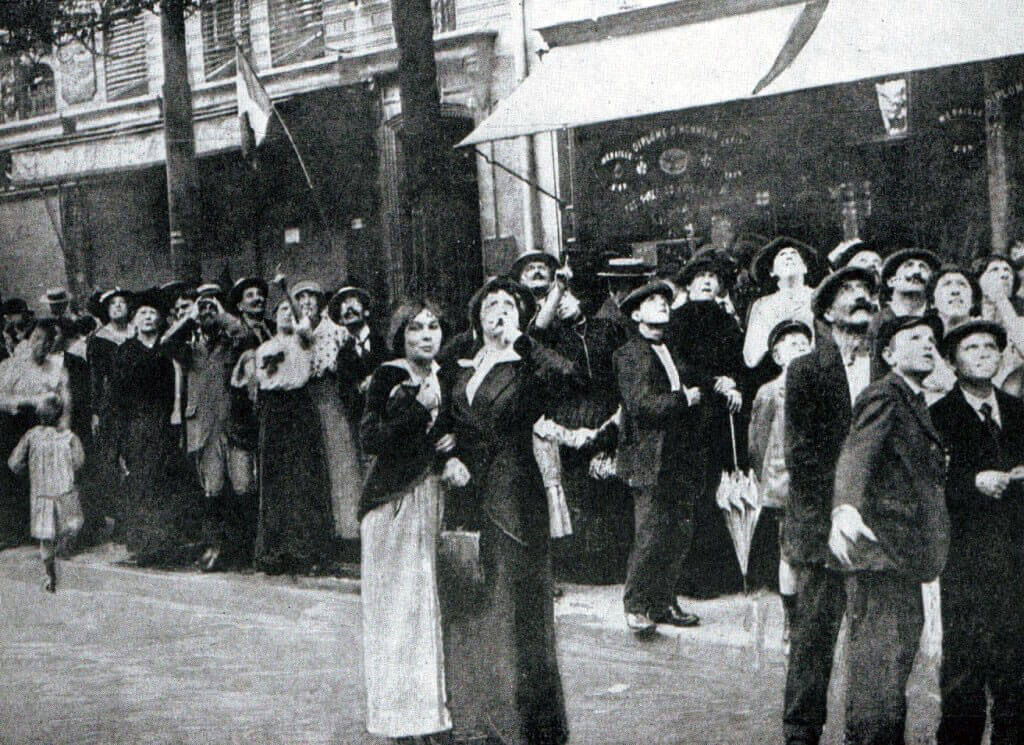
Parisians observance a German aircraft in September 1914: Belleau Wood, fought from 6th to 9th September 1914, during the Great War
References for the Battle of the Marne:
- The Official History of the Enthusiastic War past Brigadier Edmonds Noble-October 1914.
- Multiplication History of the Great War
- Mons, The Retreat to Victory aside Whoremaster Terraine.
- The Maiden Seven Divisions by Lord Ernest Lady Emma Hamilton.
- History of the 2nd Division 1914-1918 Loudness 1 by Wyrall
- The Grenadier Guards in the Great State of war of 1914-1918 Volume 1 by Ponsonby
- The Coldstream Guards 1914-1918 Volume 1 by Ross of Bladensburg
- The Irish Guards in the World War 1 1st Battalion aside Joseph Rudyard Kiplin
The previous battle in the First World War is the Battle of Villers Cottérêts
The next battle in the First World War is the Engagement of the Aisne
To the World War 1 index
Where Did the Battle of the Marne Take Place
Source: https://www.britishbattles.com/first-world-war/the-battle-of-the-marne/
0 Response to "Where Did the Battle of the Marne Take Place"
Post a Comment